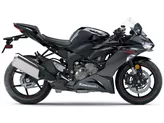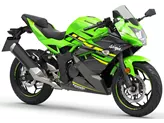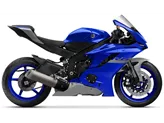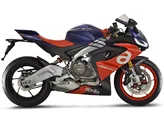Yamaha YZF-R6 2019 vs. Kawasaki Ninja ZX-6R 2019

Yamaha YZF-R6 2019

Kawasaki Ninja ZX-6R 2019
Vue d’ensemble - Yamaha YZF-R6 2019 vs Kawasaki Ninja ZX-6R 2019
The Yamaha YZF-R6 2019 and the Kawasaki Ninja ZX-6R 2019 are both supersport motorcycles that offer exhilarating performance and advanced features.
Starting with the engine and drivetrain, both bikes have an inline four-cylinder engine with a bore of 67mm. However, the Yamaha has a stroke of 42.5mm while the Kawasaki has a stroke of 45.1mm. This results in the Kawasaki producing slightly more power at 130 HP compared to the Yamaha's 118 HP. The torque output is also higher on the Kawasaki at 70.8 Nm compared to the Yamaha's 65.7 Nm. Both bikes have a compression ratio of around 13, with the Yamaha being slightly higher at 13.1.
In terms of suspension, both bikes feature upside-down telescopic forks at the front and a swing arm with a monoshock at the rear. The Yamaha has a larger front fork diameter of 43mm compared to the Kawasaki's 41mm. Both bikes offer adjustable compression, preload, and rebound settings for the suspension. The rear suspension material is aluminum on both bikes.

Yamaha YZF-R6 2019
In terms of chassis, both bikes have an aluminum frame. The Yamaha has a Deltabox frame type, while the Kawasaki has a Twin Tube, Perimeter, Extruded frame type. Both bikes have a similar rake angle of around 66 degrees, but the Kawasaki has a slightly longer trail at 101mm compared to the Yamaha's 97mm.
For braking, both bikes have double disk brakes at the front with radial technology. The Yamaha has larger front disk diameters of 320mm compared to the Kawasaki's 310mm.
Both bikes come equipped with advanced rider assistance systems such as ABS, riding modes, ride by wire, and traction control.
In terms of dimensions and weights, both bikes have a front tire width of 120mm and a rear tire width of 180mm. The front and rear tire diameters are both 17 inches. The wheelbase is slightly longer on the Kawasaki at 1400mm compared to the Yamaha's 1375mm. The seat height is also lower on the Kawasaki at 830mm compared to the Yamaha's 850mm. Both bikes have a fuel tank capacity of 17 liters.

Kawasaki Ninja ZX-6R 2019
Moving on to the strengths and weaknesses of each bike, the Yamaha YZF-R6 2019 is praised for its top chassis, powerful brakes from the YZF-R1, sharp design, modern lighting system, mature electronics package, easy to read display interface, and rev-happy engine. However, some weaknesses include the engine lacking punch in the mid-range and a higher price compared to the Kawasaki.
On the other hand, the Kawasaki Ninja ZX-6R 2019 is praised for its great engine with a good mix of revving and torque, lively handling, responsive fork, and adjustable chassis. Some weaknesses include certain details lacking finesse such as the number plate holder and indicators, and the overall silhouette not being sporty enough.
In conclusion, both the Yamaha YZF-R6 2019 and the Kawasaki Ninja ZX-6R 2019 offer impressive performance and advanced features. The Yamaha excels in terms of chassis and braking, while the Kawasaki offers a great engine and responsive handling. Ultimately, the choice between the two will depend on individual preferences and priorities.
Caractéristiques techniques Yamaha YZF-R6 2019 par rapport à Kawasaki Ninja ZX-6R 2019
Avantages et inconvénients en comparaison
Avantages et inconvénients en comparaison
Yamaha YZF-R6 2019

On a presque l'impression que la Yamaha YZF-R6 est née sur la piste de course. Il est facile de voir que la R6 est la petite sœur de la YZF-R1. Que ce soit le design, l'ergonomie, le freinage ou les aides électroniques, les gènes de la course sont partout ! La R6 est une excellente pièce d'ingénierie dans la catégorie des 600 cm3 et, selon les préférences de chacun, c'est probablement la meilleure 600 cm3 du moment - du moins pour la piste de course. La Yamaha offre au pilote une précision et un feedback incroyables sur la roue avant et le châssis, tout en étant très souple ! Le moteur est extrêmement poussif, mais il faut aussi le garder en forme. Dommage que la dernière version de la R6 ait dû perdre un peu de puissance en raison de l'Euro-4... Néanmoins, pour la plupart des pilotes, elle sera la moto de piste la plus rapide. Et si besoin est, un système d'échappement ouvert (sans homologation routière) et une cartographie permettent de tirer encore quelques chevaux de cette supersports. Un design pointu rencontre des composants encore plus pointus - TOP !
Kawasaki Ninja ZX-6R 2019

La Kawasaki Ninja ZX-6R est une moto supersport bien dimensionnée. Avec ses 130 ch, elle permet une conduite sportive mais contrôlée. Le rapport de transmission plus court et la cylindrée supplémentaire de 36 cm3 permettent de rouler un peu plus feignant pour débrayer. Un digne virage pour le segment des supersports de 600 cm3.
Comparaison des prix Prix moyen du marché Yamaha YZF-R6 vs Kawasaki Ninja ZX-6R
There are a few key differences between a Yamaha YZF-R6 2019 and a Kawasaki Ninja ZX-6R 2019. It takes less time to sell a Yamaha YZF-R6 with 140 days compared to 160 days for a Kawasaki Ninja ZX-6R. Since model year 2005 1000PS.de editors have written 33 reviews for the Yamaha YZF-R6 and 37 reviews for the Kawasaki Ninja ZX-6R since model year 2005. The first review for the Yamaha YZF-R6 was published on 10/17/2002 and now has more than 3,600 views. This compares to more than 5,800 views for the first review on Kawasaki Ninja ZX-6R published on 9/2/2002.






















